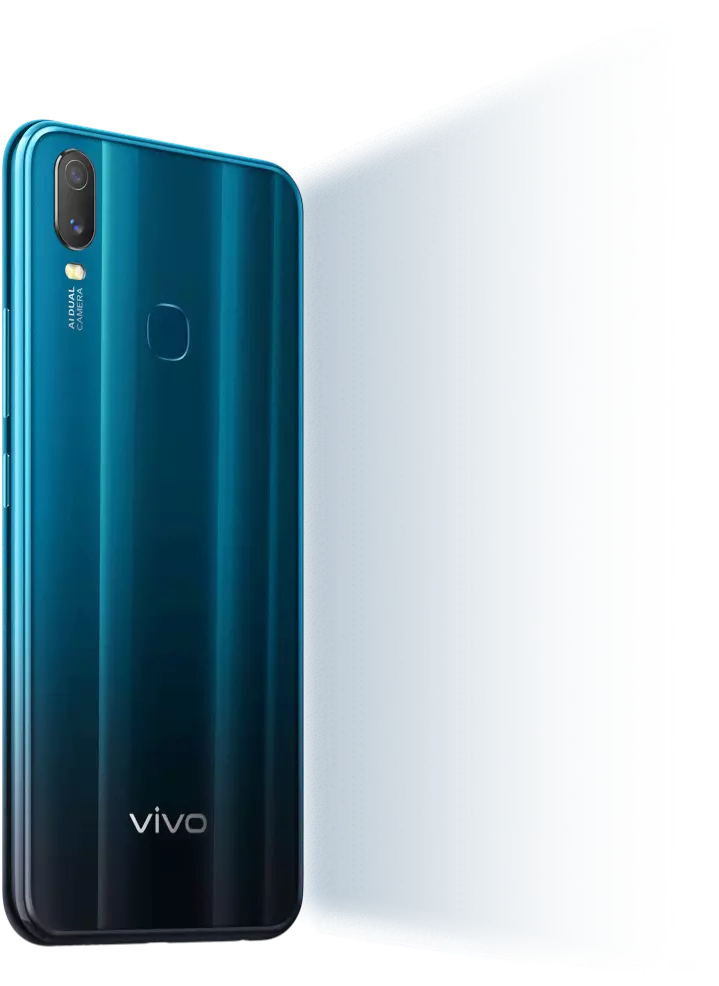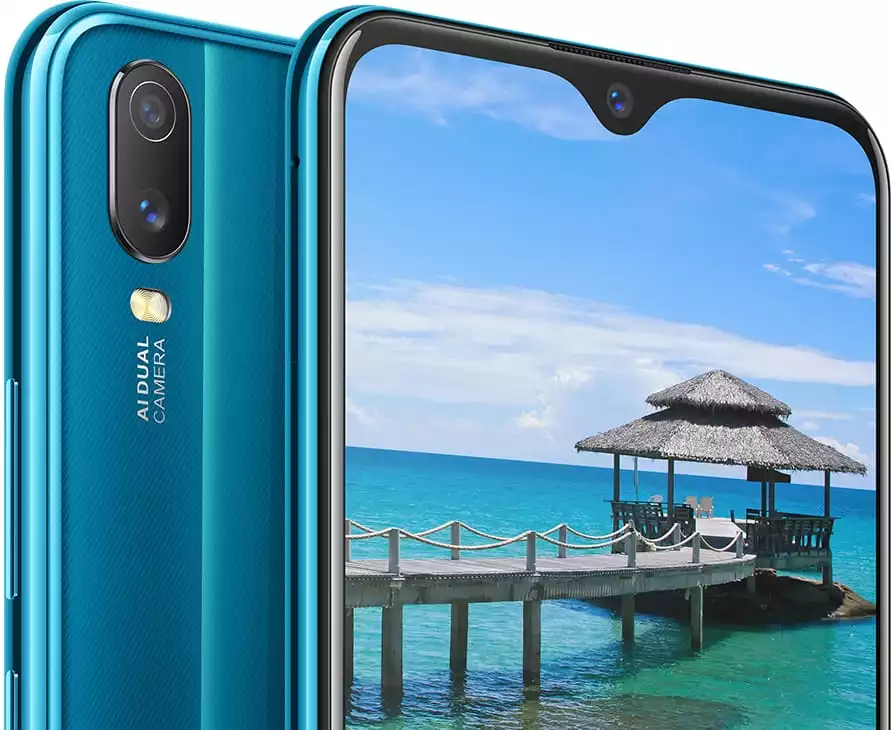

Vivo Y11 Full Specifications and Price in United States, Europe and United Kingdom:
| First Release | October 2019 |
| Colors | Mineral Blue, Agate Red |
| Connectivity | |
|---|---|
| Network | 2G, 3G, 4G |
| SIM | Dual Nano SIM |
| WLAN | Wi-Fi direct, Wi-Fi hotspot |
| Bluetooth | v4.0, A2DP, LE |
| GPS | A-GPS, GLONASS, BDS, GALILEO |
| Radio | FM |
| USB | v2.0 |
| OTG | Yes |
| USB Type-C | ✖ |
| Body | |
| Style | Minimal Notch |
| Material | Glass front, plastic back |
| Water Resistance | ✖ |
| Dimensions | 159.4 x 76.8 x 8.9 millimeters |
| Weight | 190.5 grams |
| Display | |
| Size | 6.35 inches |
| Resolution | HD+ 720 x 1544 pixels (268 ppi) |
| Technology | IPS LCD Touchscreen |
| Protection | ✖ |
| Features | Multitouch |
| Back Camera | |
| Resolution | Dual 13+2 Megapixel |
| Features | PDAF, LED flash, HDR, depth sensor & more |
| Video Recording | Full HD (1080p) |
| Front Camera | |
| Resolution | 8 Megapixel |
| Features | F/1.8 aperture |
| Video Recording | Full HD (1080p) |
| Battery | |
| Type and Capacity | Lithium-polymer 5000 mAh (non-removable) |
| Fast Charging | 10W Fast Charging |
| Performance | |
| Operating System | Android Pie v9.0 (FunTouch OS 9.1) |
| Chipset | Qualcomm Snapdragon 439 (12 nm) |
| RAM | 3 GB |
| Processor | Octa core, up to 1.95 GHz |
| GPU | Adreno 505 |
| Storage | |
| ROM | 32 GB |
| MicroSD Slot | up to 256 GB (dedicated slot) |
| Sound | |
| 3.5mm Jack | Yes |
| Features | Loudspeaker |
| Security | |
| Fingerprint | On the back |
| Face Unlock | Yes |
| Others | |
| Notification Light | |
| Sensors | Fingerprint, Accelerometer, Gyroscope, Proximity, E-Compass |
| Manufactured by | Vivo |
Vivo Y11 Price in United States, Europe and United Kingdom:
| United States | $ 150.00 |
| Europe | € 130.00 |
| United Kingdom | £ 71.00 |




The Vivo Y11 is a stylish and powerful smartphone that offers a superior mobile experience. With a large 6.35-inch HD+ display, it provides an immersive visual treat, perfect for watching videos, playing games, and browsing the web. The phone is powered by a robust octa-core processor, ensuring smooth and efficient performance for demanding tasks.
The Vivo Y11 excels with a dual rear camera setup, comprising a high-resolution primary sensor and a secondary sensor for capturing depth information. This advanced camera system allows you to take stunning photos and videos with ease and even supports features like portrait mode and night mode. The phone also sports a capable front camera for selfies and video calls.
The Vivo Y11 also boasts a long-lasting 5000mAh battery, which easily lasts throughout the day, even with moderate usage. And with support for 18W fast charging, you can quickly top off your phone when needed.
Design-wise, the Vivo Y11 flaunts a sleek and modern look, with a unique gradient finish that adds a touch of style to its durable polycarbonate body. The phone also features a responsive fingerprint scanner and face unlock feature for secure biometric authentication.
Overall, the Vivo Y11 is a fantastic value for anyone looking for a feature-packed smartphone that won’t break the bank. With its powerful performance, advanced cameras, and long-lasting battery, this phone is sure to impress.
Disclaimer: We can not guarantee that the information on this page is 100% correct. Read more
FAQ:
- Display: The screen display is one of the most important parts of a smartphone. It shows the user interface, apps, photos, videos, and other visual content. Displays come in different sizes, resolutions, and technologies such as LCD, OLED, AMOLED, and Retina.
- Processor: The processor is the brain of a smartphone. It handles all the calculations, operations, and tasks that the phone performs. Popular smartphone processors include Qualcomm Snapdragon, Apple A-series, and Huawei Kirin.
- RAM (Random Access Memory): RAM temporarily stores data and applications that the processor uses. More RAM means faster performance, smoother multitasking, and better gaming experience. Most smartphones have at least 4GB of RAM, but some high-end models offer up to 16GB or more.
- Storage: Smartphones have internal storage where the operating system, apps, photos, videos, and other files are stored. Some phones also have expandable storage via microSD cards. Common storage capacities range from 16GB to 512GB.
- Camera: Smartphone cameras have improved significantly over the years, offering advanced features like optical zoom, portrait mode, night mode, and video recording in 4K or higher resolution. Front cameras are typically used for selfies and face recognition.
- Battery: The battery life of a smartphone depends on various factors like screen size, processor, usage patterns, and software optimization. Many smartphones now support fast charging, wireless charging, or both. Battery capacities usually range between 2000mAh and 5000mAh.
- Operating System: The operating system manages the hardware and software resources of a smartphone. Popular smartphone OSes include Android, iOS, and Windows. Each has its unique features, app ecosystem, and user interface.
- Connectivity: Smartphones often feature multiple connectivity options like Wi-Fi, Bluetooth, NFC, GPS, and cellular networks (e.g., 4G, 5G). These allow users to access the internet, pair devices, navigate, and communicate with others.
- Audio: Smartphones may have speakers, earpieces, or headphones for audio output. Some phones also have specialized audio chipsets for enhanced sound quality or noise cancellation.
- Sensors: Various sensors inside smartphones enable features like fingerprint scanning, facial recognition, accelerometer, gyroscope, proximity detection, and ambient light measurement. These enhance user experience, security, and functionality.
- Durability: Smartphones are made with materials like glass, metal, or plastic. Some phones have IP ratings for dust and water resistance, which protect against accidental exposure to liquids or solid particles.
- Charging port: Smartphones require charging ports to replenish their batteries. Common charging ports include USB-C, Lightning (for iPhones), and Micro-USB (less common nowadays). Wireless charging pads or stands eliminate the need for cables.
- Buttons and controls: Physical buttons and touch controls facilitate navigation and operation. Common buttons include power, volume, and camera shutter release. Some phones use on-screen navigation keys or gesture-based interfaces.
- Antennas: Smartphones contain antennas for cellular communication, GPS, and Wi-Fi. They may be located at the top or bottom edges, or integrated into the device’s body.
- Fingerprint reader: Many smartphones feature fingerprint readers for biometric authentication. These can be physical buttons or optical scanners embedded under the display. Face ID systems are also becoming popular alternatives.